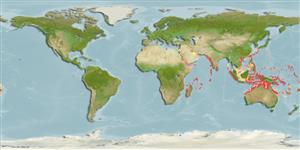Common names from other countries
Classification / Names / Names
народные названия | синонимы | Catalog of Fishes (gen., sp.) | ITIS | CoL | WoRMS
Environment: milieu / climate zone / depth range / distribution range
экология
; пределы глубины 0 - 55 m (Ref. 81020). Tropical
Indo-West Pacific.
Length at first maturity / Size / Вес / Возраст
Maturity: Lm ? range ? - ? cm Max length : 2.5 cm WD самец/пол неопределен; (Ref. 87041)
Size refers to disc diameter (Ref. 87041). Found in waters less than 30m. Associated with coral communities. Conceals itself beneath rocks, rubble and in cavities (Ref. 129602).
Life cycle and mating behavior
половая зрелость | размножение | нерест | икра | Fecundity | личинки
Members of the class Ophiuroidea are mostly gonochoric, others are protandric. Fertilization is external. Brooding is common, bursae is used as brood chambers where the embryos develop into juveniles and later crawl out from the bursal slits. Life cycle: Embryos hatch into free-swimming planktotrophic larvae and later metamorphose into tiny brittle stars which sink down the bottom where they grow into adult form.
Основная ссылка
ссылки | координатор | соавторы
Lane, D.J.W., L.M. Marsh, VandenSpiegel and F.W.E. Rowe. 2000. (Ref. 81020)
Статус Красного Списка МСОП (Ref. 130435)
Статус СИТЕС (Ref. 108899)
Not Evaluated
Not Evaluated
Использование человеком
| FishSource |
инструменты
дополнительная информация
Возраст/Размеры
рост
Зависимость между длиной и массой тела
Зависимость между длинами
морфология
личинки
численность
ресурсы в Интернет
Estimates based on models
Preferred temperature
(Ref.
115969): 24.9 - 29, mean 27.7 (based on 648 cells).
